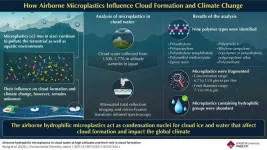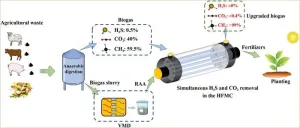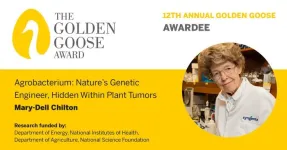(Press-News.org) The Department of Energy’s Oak Ridge National Laboratory announced the establishment of its Center for AI Security Research, or CAISER, to address threats already present as governments and industries around the world adopt artificial intelligence and take advantage of the benefits it promises in data processing, operational efficiencies and decision-making.
In partnership with federal agencies such as the Air Force Research Laboratory’s Information Directorate and the Department of Homeland Security (DHS) Science and Technology Directorate (S&T), ORNL and CAISER will provide objective scientific analysis of the vulnerabilities, threats and risks — from individual privacy to international security — related to emerging and advanced artificial intelligence.
“One of the biggest scientific challenges of our time is understanding AI vulnerabilities and risks,” said ORNL Deputy for Science and Technology Susan Hubbard. “ORNL is already advancing the state of the art in AI to solve the Department of Energy’s most pressing scientific challenges, and we believe the lab can help DOE and other federal partners answer critical AI security questions while providing insights to policymakers and the public.”
CAISER expands the lab’s long-standing Artificial Intelligence for Science and National Security research initiative, which integrates ORNL’s unique expertise, infrastructure and data to accelerate scientific breakthroughs.
“There are real benefits the public and government can gain from AI technologies,” said Prasanna Balaprakash, director of AI programs at ORNL. “CAISER will put the lab’s expertise toward understanding threats and ensuring people can benefit from AI in safe, secure, peaceful ways.”
Past research has established that AI systems are vulnerable to different types of attacks. Adversaries can “poison” an AI model, for instance, by covertly injecting malicious data into the training dataset to intentionally corrupt and alter the output. Other studies have shown that small physical objects can fool an AI-based detection algorithm — a few small pieces of black tape on a stop sign, for example, can render the object unrecognizable to vehicle autopilot systems. Additionally, generative AI, such as ChatGPT and DALL-E, can be used to create entirely synthetic text and imagery, known as deepfakes, that are nearly indistinguishable from “real” content.
“We are at a crossroads. AI tools and AI-based technologies are inherently vulnerable and exploitable, which can lead to unforeseen consequences,” said Edmon Begoli, ORNL’s Advanced Intelligent Systems section head and CAISER founding director. “We’re defining a new field of AI security research and committing to intensive research and development of mitigating strategies and solutions against emerging AI risks.”
By elucidating a clear, science-based picture of risks and mitigation strategies, CAISER’s research will provide greater assurance to federal partners that the AI tools they adopt are reliable and robust against adversarial attacks.
“I think a lot about the challenges of our current era, as well as those that lie ahead in the uncharted territory of AI technologies and the very real threats that we’re working steadfast to understand and mitigate,” said the Honorable Dimitri Kusnezov, DHS Under Secretary for Science & Technology. “Throughout its history, DHS has always had a special partnership with DOE’s national laboratories, tirelessly pioneering ground-breaking science for American security. CAISER will play a critical role in helping us understand this future and addressing the looming threats together.”
CAISER provides a dedicated research center for the lab’s experts and collaborators to:
Lead basic and applied scientific research into the vulnerabilities, risks and national security threats related to AI.
Develop capabilities to test and evaluate the robustness and vulnerabilities of AI tools and products.
Produce strategic reports and scientific studies in collaboration with industry and national security partners.
Provide educational outreach and information to inform the public, policymakers and the national security community.
Initially, CAISER will focus on four national security domains that align with ORNL strengths — AI for cybersecurity, biometrics, geospatial intelligence and nuclear nonproliferation — in collaboration with national security and industry partners.
“Artificial Intelligence promises to do many wonderful things for nearly every aspect of society,” said Col. Fred Garcia, director of the AFRL Information Directorate. “CAISER gives hope that while the world rushes full force into AI implementation, they can rest assured that vulnerabilities are being studied and that the back door is being guarded. We’re excited to be part of this new research venture with ORNL.”
As ORNL celebrates its 80th anniversary this year, CAISER is a logical step in the laboratory’s history of solving big problems, advancing emerging fields of science and delivering global impact. With established programs in both cybersecurity research and AI research, ORNL is uniquely suited to launch CAISER and, with it, the field of AI security research.
“We’re very proud of the laboratory’s legacy of scientific discovery in nuclear energy, biological sciences, high-performance computing, materials research and artificial intelligence,” said Moe Khaleel, associated laboratory director for National Security Sciences at ORNL. “CAISER will approach the AI challenge in the same way, developing capabilities to scientifically observe, analyze and evaluate AI models in support of national needs.”
The Department of Homeland Security (DHS) Science and Technology Directorate’s (S&T) mission is to enable effective, efficient, and secure operations across all homeland security missions by applying scientific, engineering, analytic, and innovative approaches to deliver timely solutions and support departmental acquisitions. Created by Congress in 2003, S&T conducts basic and applied research, development, demonstration, testing and evaluation activities relevant to support Homeland Security and first responder operations and protect critical infrastructure. For more information about S&T, visit https://www.dhs.gov/science-and-technology.
UT-Battelle manages ORNL for the Department of Energy’s Office of Science, the single largest supporter of basic research in the physical sciences in the United States. The Office of Science is working to address some of the most pressing challenges of our time. For more information, please visit energy.gov/science.
END
ORNL launches Center for AI Security Research to study AI’s impacts on society, security
2023-09-27
ELSE PRESS RELEASES FROM THIS DATE:
Extreme weight loss: Star sheds unexpected amounts of mass just before going supernova
2023-09-27
Cambridge, Mass. — A newly discovered nearby supernova whose star ejected up to a full solar mass of material in the year prior to its explosion is challenging the standard theory of stellar evolution. The new observations are giving astronomers insight into what happens in the final year prior to a star’s death and explosion.
SN 2023ixf is a new Type II supernova discovered in May 2023 by amateur astronomer Kōichi Itagaki of Yamagata, Japan shortly after its progenitor, or origin star, ...
Target: BP™ intitiative helps more than 8.6 million Americans with hypertension improve heart health
2023-09-27
DALLAS, September 27, 2023 — The American Heart Association and American Medical Association (AMA) nationally recognized 1,709 health care organizations (HCOs) — 400 more than in 2022 — for their efforts to prioritize control of their patients’ blood pressure (BP), a leading preventable risk factor for heart disease, stroke and premature death.
According to the 2022 American Heart Association Statistical Update, nearly half of U.S. adults — 121.5 million ...
Tiny CRISPR tool could help shred viruses
2023-09-27
HOUSTON – (Sept. 27, 2023) Small and precise: These are the ideal characteristics for CRISPR systems, the Nobel-prize winning technology used to edit nucleic acids like RNA and DNA.
Rice University scientists have described in detail the three-dimensional structure of one of the smallest known CRISPR-Cas13 systems used to shred or modify RNA and employed their findings to further engineer the tool to improve its precision. According to a study published in Nature Communications, the molecule works differently than other proteins in the same family.
“There are different types of CRISPR systems, and the one ...
Plastic cloud: New study analyzes airborne microplastics in clouds
2023-09-27
Plastic particles less than 5 mm in size are called “microplastics.” These tiny bits of plastic are often found in industrial effluents, or form from the degradation of bulkier plastic waste. Research shows that large amounts of microplastics are ingested or inhaled by humans and animals alike and have been detected in multiple organs such as lung, heart, blood, placenta, and feces. Ten million tons of these plastic bits end up in the ocean, released with the ocean spray, and find their way into the atmosphere. This implies that microplastics may have become an essential component of clouds, ...
Winners of the ASTRO-Sumitomo Pharma-Pfizer Alliance new combination therapy challenge announced
2023-09-27
ARLINGTON, Va., September 27, 2023 — The American Society for Radiation Oncology (ASTRO) today announced the three winning research proposals for the 2022 ASTRO-Myovant Sciences (now known as Sumitomo Pharma)-Pfizer Alliance New Combination (Relugolix-Radiation) Therapy Challenge. The Challenge aims to identify research that addresses ways prostate cancer treatments can be improved with the gonadotropin-releasing hormone (GnRH) receptor antagonist relugolix in patients who received radiation therapy.
The Challenge invited researchers to propose the study of relugolix in different scenarios: ...
New evidence for sub-network specializations within the Default Mode Network and the Special Role of Facial Movements in Brain Activation and Self-Perception
2023-09-27
Recent advancements in neuroscience have unveiled new insights into the neural processes responsible for self-referential cognition. This research has brought particular attention to a critical neural network known as the Default Mode Network (DMN), comprising brain regions such as the medial prefrontal cortex (mPFC), posterior cingulate cortex, temporoparietal junction (TPJ), and both lateral and medial temporal lobes.
Central to self-related processing, is the information associated with one’s ...
Ultrasound enables gene delivery throughout the brain
2023-09-27
HOUSTON – (Sept. 27, 2023) – Rice University researchers tested the safety and feasibility of gene delivery to multiple brain regions using a noninvasive, ultrasound-based technique in rodents, and their findings suggest that the efficiency of gene delivery improves within each targeted site when more sites are opened.
Shirin Nouraein, a doctoral student working in the lab of Rice bioengineer Jerzy Szablowski, is the lead author on the study recently published in the journal Gene Therapy.
The paper, “Acoustically Targeted Noninvasive Gene Therapy in Large Brain Volumes,” ...
Elevating biogas upgrading performance on renewable aqueous ammonia solution via a novel “membrane method”
2023-09-27
Biogas is usually produced by anaerobic digestion of organic waste such as animal manures and straw wastes, which is a typical green renewable energy and can be used as a fuel for power generation and heat production. China has owned large scale of biogas production, with an annual output of about 15 billion m3 biogas, and the biogas development and utilization provide a new choice for coping with the energy crisis. Factually, biogas contains about 60% CH4 and about ...
Golden Goose Award announces 2023 awardees for discoveries in DNA sequencing technique, a bacteria-inspired method that saves crops and chicken pedigree lines
2023-09-27
WASHINGTON, D.C. – The Golden Goose Award, which celebrates federally funded research that sounds silly, but ultimately benefits society, has selected five researchers across the fields of biology, agriculture and genomics for their unexpected breakthroughs as 2023 awardees. On September 27, 2023, the American Association for the Advancement of Science (AAAS), the world’s largest multidisciplinary scientific society, will co-host the 12th annual Golden Goose Award ceremony with the Association of American Universities, a founding member of the Golden Goose Award, at the Library ...
Inventors of nanopore sequencing honored at Library of Congress
2023-09-27
Two UC Santa Cruz researchers were honored on September 27 at the Library of Congress for the invention of nanopore sequencing, which became a new and revolutionary method to read DNA and RNA.
David Deamer and Mark Akeson, both emeritus professors of biomolecular engineering at the Baskin School of Engineering, received the American Association for the Advancement of Science’s (AAAS) Golden Goose Award for the invention. Their colleague and friend Daniel Branton, a Havard biologist and co-inventor of the technology, was also honored.
The Golden Goose award is given to scientists whose federally-funded research ...










